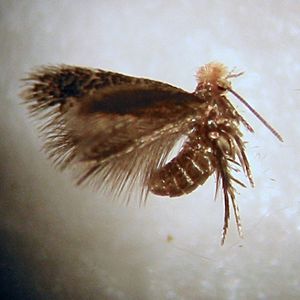Stigmella ogygia facts for kids
Quick facts for kids Stigmella ogygia |
|
|---|---|
 |
|
| Scientific classification | |
| Synonyms | |
|
The Stigmella ogygia is a tiny moth that belongs to a family called Nepticulidae. These moths are known for being some of the smallest moths in the world! This particular moth is special because it is found only in New Zealand.
Contents
About the Stigmella Ogygia Moth
What Does It Look Like?
The Stigmella ogygia moth is very small. Its front wings, called forewings, are only about 3 millimeters long. That's about the size of a tiny ant! The larvae, which are the young caterpillars of the moth, are also small. They are usually 3 to 4 millimeters long and are a pale green color.
Where Does It Live?
This moth lives in New Zealand. It is considered an endemic species, which means it naturally lives only in that country and nowhere else in the world.
Life Cycle of the Moth
The Stigmella ogygia moth goes through several stages in its life, just like other moths. This process is called a life cycle.
When Do Adults Appear?
Adult moths have been seen flying in March, July, and from September to December. Scientists have also raised these moths in labs. The moths they raised hatched in January, April, May, and August. This suggests that new generations of Stigmella ogygia moths might be born continuously throughout the whole year.
What Do the Larvae Eat?
The young moths, or larvae, are very interesting. They mostly eat the leaves of plants from the Senecio family. Some of their favorite plants include Senecio biserratus and Senecio minimus.
How Do Larvae Feed?
These larvae are known as "leaf miners". This means they tunnel and eat their way inside the leaves of their host plants. The tunnel they create is narrow and winding, like a snake, and it stays close to the top surface of the leaf. As the larva grows, the tunnel gets wider at the end.
Inside their tunnels, the larvae leave behind their waste, called frass. They usually deposit this frass in the middle of their tunnel. Larvae have been found in leaves from April to September, and also in November and December.
Where Do They Sleep?
When a larva is ready to change into an adult moth, it builds a special home called a cocoon. The cocoon of the Stigmella ogygia moth is made of brown silk. It is usually found attached to the stem of the plant where the larva was feeding.

